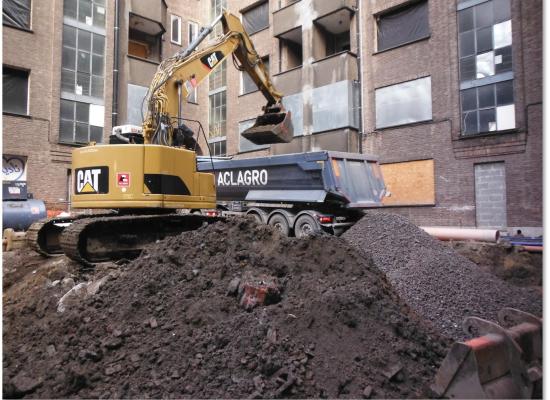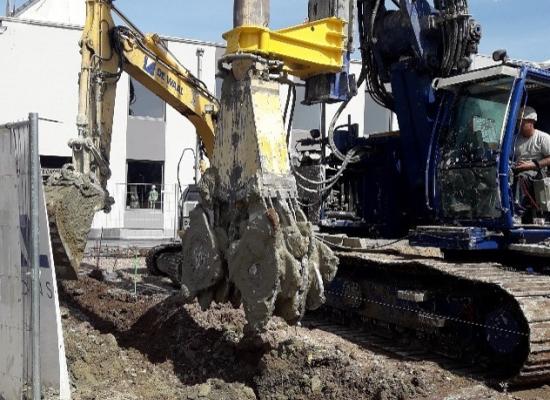Due to a historical soil contamination with mineral oil (MO), polycyclic aromatic hydrocarbons (PAKs) in the solid portion of the soil, and MO, PAKs, and BTEX in the groundwater at G. Naudtslaan 8-10-12 in 9185 Wachtebeke, on plots 482 A3, 482 C3, 482 D3, 493R, 493S, and 507 C, it was determined that this contamination posed a human toxicological risk (current/potential) and a risk of spreading.
Overall, a severe threat was identified from this soil contamination, and the urgency of the situation was paramount. No safety measures, precautions, zoning restrictions, or usage limitations were in place. If the warehouses were to be demolished in the future, the excavation/removal of the residual contamination would need to adhere to soil transport regulations.
For plots 482 A3, 482 C3, 482 D3, 493 R, 507 C,
Soil remediation was carried out at the source plots through a core excavation combined with pumping of both contamination cores. At Core I (depending on height restrictions), excavation was conducted to approximately 3 to 4 or 5 meters below ground level. Tube excavation was employed around the burned-down warehouse, with the outer 3 rows backfilled with sand-cement. For the walls of the other warehouses, excavation was done incrementally and alternately. Other zones were excavated with a free slope. Core II at the rear of the site at P604 was excavated to 2 meters below ground level, sloping, with the exception of zones along the buildings where incremental excavation was done and backfilled with sand-cement. The excavation was carried out in phases to ensure access to the rear plot. The excavation combined with pumping was planned for approximately 12 weeks. Temporary measures were taken during excavation and installation of pumping filters to prevent odor, dust, and noise disturbances. After completing active works, groundwater sampling needs to continue for a period of 3 years at multiple monitoring wells on these plots. This period can be extended for another 3 years based on evaluation. In case of unfavorable groundwater results, a groundwater extraction using 19 deep well filters can serve as a backup measure, placed across the entire contamination zone. The goal of the remediation was/is to eliminate human and spreading risks by achieving risk-based remediation standards.
For Plot 493 S
Apart from the plot where work was conducted, only groundwater contamination was present. No active remediation zone was established for this plot; however, addressing the contamination core in neighboring plots was expected to halt the contamination transport to the groundwater, positively influencing groundwater concentrations on this plot. This plot is categorized as a non-remediation plot without active work.
For Plot 482 B3 en 493 P
The contamination contours did not extend to these plots. However, due to the ongoing remediation works on adjacent plots, limited disruption was expected on these plots during transportation, etc. These plots were designated as locations of limited impact.
Throughout the entire project, approximately 11,000 tons of soil were transported to the soil treatment center.



